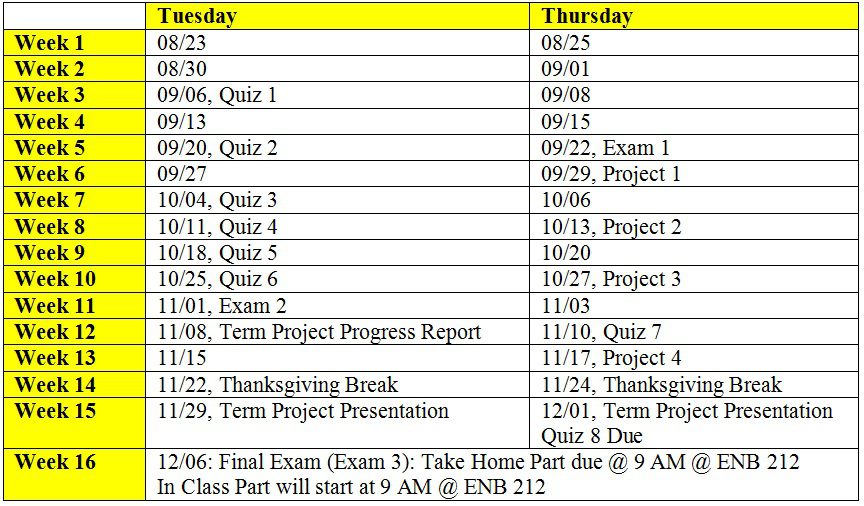Exam 3 (Take Home Part) posted. Click here. Due on: Dec. 6 @ 9 AM in Room ENB 212.
Exam 3 (In-class Part) Reading List posted. Click here.
Exam 3 (In-class Part) will be on Dec. 6 @ 9 AM in Room ENB 212.
Quiz 8 (Take Home) posted. Due on: Dec. 1 @ 11.30 AM. NO late submissions!
TERM PROJECT PRESENTATION SCHEDULE
—————————————————–
Syllabus
Lecture Slides
Question Bank
Project Descriptions
Term Project
Quizzes and Exams
Code Tutorial
Dr. Meg's Desktop Selected Lecture Videos
Quiz, Exam and Project Schedules
—————————————————–
Syllabus
Lecture Slides
Module 1: Algorithm Efficiency Analysis
Module 2 – Classical Design Techniques
Module 6: NP-Complete Problems and Heuristics
Question Bank
QB Module 1: Algorithm Efficiency Analysis
QB Module 2 – Classical Design Techniques
QB Module 4 – Dynamic Programming
QB Module 5 – Graph Theory Algorithms
Project Descriptions
Project 1: Element Uniqueness Problem, Due: Sept. 29
Project 2: Iterative vs. Recursive Algorithms to Compute the Factorial of an Integer, Due: Oct. 13
Project 4: Optimum Coin Collection in a Two-Dimensional Grid, Due: Nov. 17
Term Project
Term Project Descriptions and Team Assignments
Team 1: Algesa Haywood Jr., Brian Williams, Michael D. Moore
Team 2: Kabinad Melaku, Kirubel Benalfew, YosefGetachew
Team 3: Karmeen Powell-Childress & Deonta Kilpatrick
Team 4: Quavanti Hart, Nicholas Whitfield, Alishia Harmon
Team 5: Darius Leroy, Ladarius Felix, Shawndon Portis
Quizzes and Exams
Quiz 3 (Take Home): Due on Oct. 4 at 11.30 AM
Quiz 4 and Bonus Quiz 1 (Take Home): Due on Oct. 11 at 11.30 AM
Quiz 6 (Take Home; Due: Oct. 25 @ 11.30 AM)
Exam 2 (Take Home; Due: Nov. 1 @ 11.30 AM)
Quiz 7 (Take Home: Due on Nov. 10 @ 11.30 AM)
Quiz 8 (Take Home) posted. Due on: Dec. 1 @ 11.30 AM
Code Tutorial
Dr. Meg's Desktop Selected Lecture Videos (YouTube Links)
Module 1 (Chapter 2): Analyzing the Efficiency of Algorithms
Time-Complexity analysis of a recursive algorithm to compute the factorial of an integer
Example for solving recurrence relations
Time-complexity analysis of an iterative algorithm to determine whether an array has unique elements
Module 2 (Chapters 3-6): Classical Algorithm Design Techniuqes
Brute Force Algorithms QB – String Matching Problems
Decrease and Conquer – Insertion Sort Algorithm and Examples
Divide and Conquer – Theorem-Proof: In order Traversal of a Binary Search Tree
Divide and Conquer – Master Theorem
Binary Search Algorithm and Examples
Comparison of Bottom-up and Top-down Approaches for Heap Construction
Transform and Conquer – Proof for Euclid's GCD Formula
Transform and Conquer – Heap Sort
Space-Time Tradeoffs for the Sorting Algorithms (Merge, Insertion and Heap Sorts)
Module 3 (Chapter 9): Greedy Technique
Greedy Technique – Fractional Knapsack Problem
Greedy Technique – Huffman Codes (Variable Length Prefix-free Encoding)
Module 4 (Chapter 8): Dynamic Programming
Dynamic Programming: Coin-row Problem Discussion and Example
Dynamic Programming: Binomial Coefficient
Dynamic Programming Solution for the Coin Collecting Problem in a Two-Dimensional Grid
Dynamic Programming: Integer Knapsack Problem (0-1 Knapsack Problem)
Module 5: Graph Theory Algorithms
Depth First Search on Directed Graph
Depth First Search and Articulation Points
Breadth First Search and 2-Colorability of Graphs
Topological Sort on DAGs and Proof for Neccessary and Sufficient Condition
Dijkstra's Algorithm for Shortest Path Trees and Proof for Correctness
Bellman-Ford Algorithm for Shortest Path Trees and Examples New!!
Kruskal's Algorithm: Examples to find Minimum Spanning Trees
Kruskal's Algorithm: Proof of Correctness
Properties (1 and 2) of Minimum Spanning Tree: IJ-Cut and Minimum Weight Edge
Prim's Algorithm for Minimum Spanning Trees and Proof for Correctness
Floyd's All Pairs Shortest Paths Algorithm
Part 1 Part 2 Part 3 Part 4 Part 5 Part 6 Part 7
Module 6: P, NP and NP-Complete Problems
Polynomial Reduction: Hamiltonian Circuit to Traveling Salesman Problem
Polynomial Reductions: Independent Set, Clique and Vertex Cover
Multi-fragment Heuristic for the Traveling Salesman Problem
Quiz, Exam and Project Schedules

